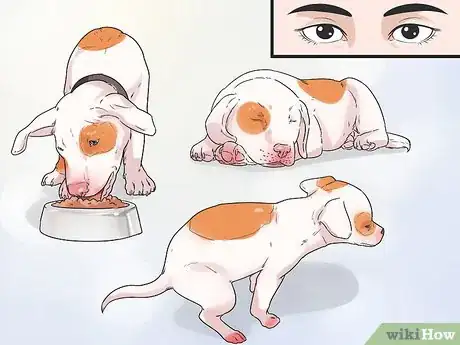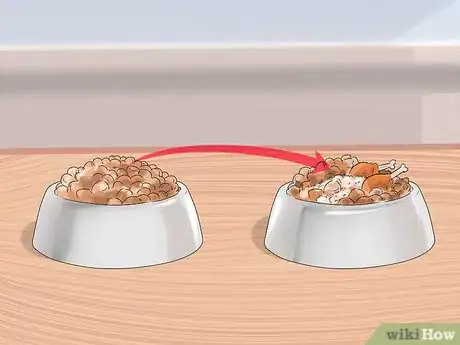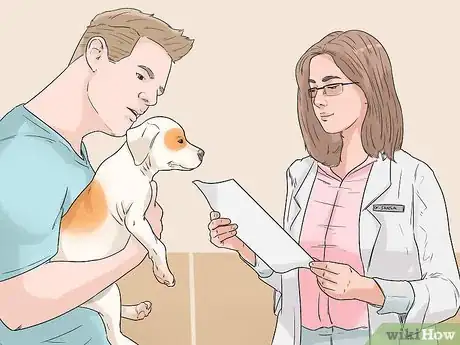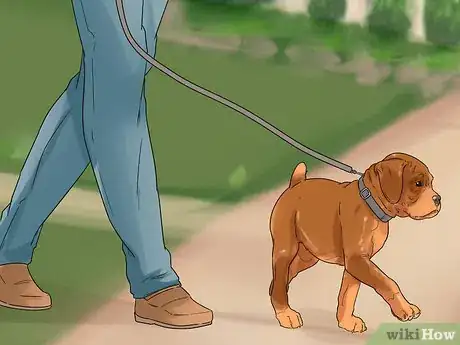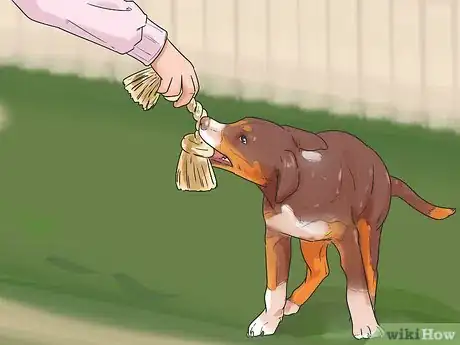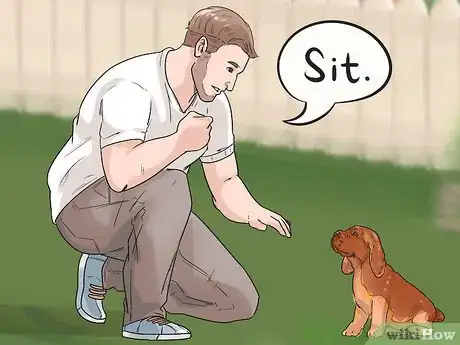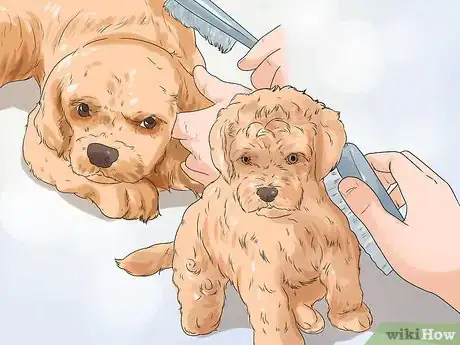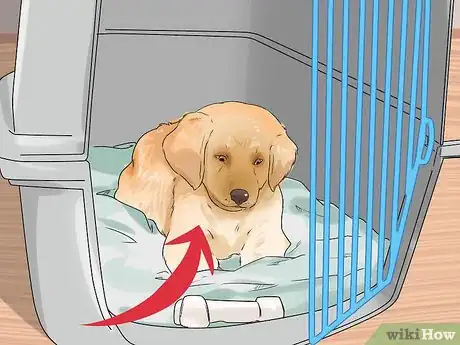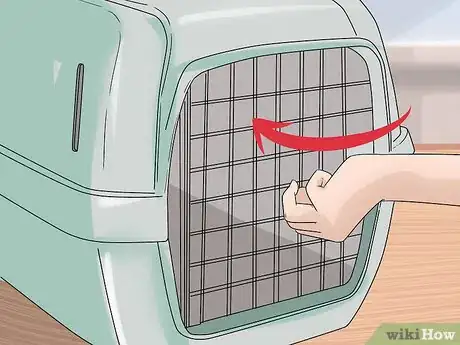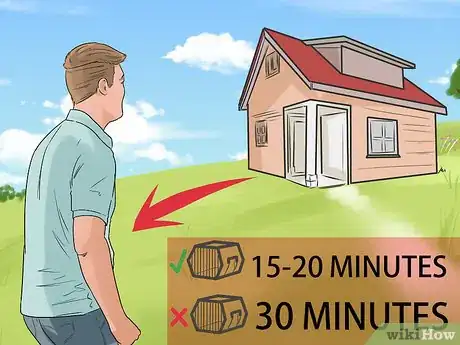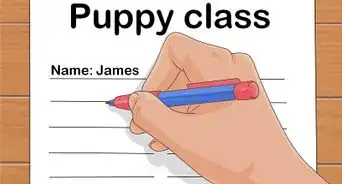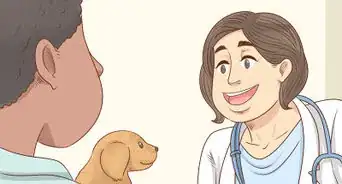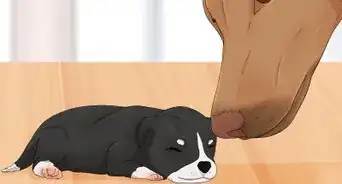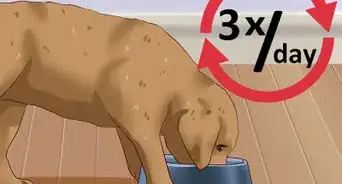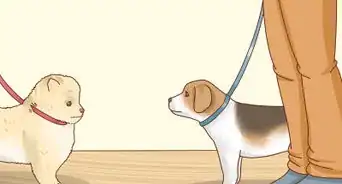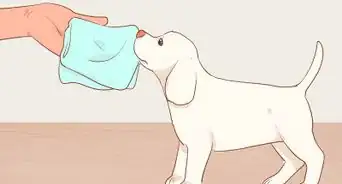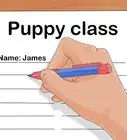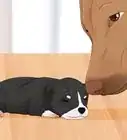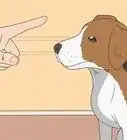This article was co-authored by Deanne Pawlisch, CVT, MA. Deanne Pawlisch is a Certified Veterinary Technician, who does corporate training for veterinary practices and has taught at the NAVTA-approved Veterinary Assistant Program at the Harper College in Illinois and in 2011 was elected to the board of the Veterinary Emergency and Critical Care Foundation. Deanne has been a Board Member of the Veterinary Emergency and Critical Care Foundation in San Antonio, Texas since 2011. She holds a BS in Anthropology from Loyola University and an MA in Anthropology from Northern Illinois University.
There are 9 references cited in this article, which can be found at the bottom of the page.
This article has been viewed 34,239 times.
Dealing with a restless puppy can be difficult, but there are many steps you can take to calm your new pet. First rule out health problems as a cause for restlessness by observing it, adjusting its diet, and taking it to a vet, if necessary. Keep your puppy busy by teaching it basic commands, giving it exercise, playing with it, and grooming it. Use crate training as a measure to calm your restless puppy, but not to punish it.
Steps
Ruling Out Health Problems
-
1Observe your puppy's habits. While a bit of unruliness and excess energy is normal for puppies, restlessness can be a symptom of health ailments as well. Monitor your puppy's eating, eliminating, and sleeping patterns to look for any red flags. For instance, if your puppy has not had a bowel movement in over 24 hours, its restlessness is likely due to constipation.[1]
- To stay organized, keep a journal to track your puppy's health. Note any other irregularities that may occur (e.g. skin irritation).
-
2Try changing its diet. Environmental allergies are very common in dogs, but dogs can also be allergic to specific foods. If your puppy demonstrates other signs of an allergy (e.g. a lack of appetite, poor weight gain, skin irritations), its restlessness might also be a symptom. Try changing to a different high quality pet food (with no preservatives and additives) over the course of several days to avoid shocking your puppy's digestive system, and see if the restlessness subsides.[2]
- Introduce a bit of the new food in with your puppy's regular food, reducing the regular food accordingly. Over the next few days, increase the portion of the new food until you replace the old food completely.
Advertisement -
3Visit the vet. If your puppy's restlessness is intense enough to cause concern, bring it to the vet immediately. Unusual or aggressive behaviour can be a sign of serious health ailments like tumors, parasites, or diabetes. A veterinarian will be able to determine if the underlying cause of your puppy's restlessness is a physiological issue, and suggest other options if it isn't (e.g. changes to diet, exercise, and living environment).[3]
Keeping Your Puppy Busy
-
1Give it plenty of exercise. At its young age, your puppy should be exercising regularly and consistently, but not too vigorously. Exercise provides mental stimulation and helps your dog avoid arthritis and joint problems later in life, and will usually result in calmer behavior afterwards. Ideally, your dog should be getting 5 minutes of low-impact exercise for each month of age, twice a day (i.e. a 3 month old dog will need 15 minutes of exercise, twice a day).[4]
- Low-impact exercise may include going for short walks, playing in the yard, or supervised swimming.
-
2Play games. Your puppy's restlessness may be due to boredom, so try playing games with it to keep it occupied. Basic games like tug of war, fetch, and hide and seek are simple enough to play with a puppy. To play hide and seek, for instance, tell your puppy to sit and stay, show it a treat, then hide in another room and call it to you. The game relies on and improves your puppy's sense of smell and develops its ability to come when called.
- Provide puzzle toys for your puppy whenever you aren’t able to give it your full attention. These will keep your puppy busy and stimulated.
-
3Teach it basic commands. At around 12-16 weeks old, try teaching your puppy basic commands using the reward method. Rewards should be anything that your puppy enjoys (e.g. treats, favorite toys). Initial training should happen in short, 10-15 minute sessions and be an enjoyable process for you and your puppy.[5]
- Visit the American Kennel Club website at http://www.akc.org/content/dog-training/articles/teach-your-puppy-these-5-basic-commands/ for a detailed guide and instructional videos on how to teach your puppy five basic commands:"Sit”,"Stay", "Lay down”, ”Heel”, and "Come here”.
-
4Groom your puppy. Grooming your puppy from an early age is important to get it used to being handled (as it will be by veterinarians and groomers in the future, for instance). It also keeps your puppy clean and helps to forge a bond with its owner(s). Grooming can include baths, brushing, nail trimming, and ear cleaning, and it should happen in some form as often as once a day.[6]
-
5Socialize your puppy. Socialization shapes and improves your dog's temperament, and is a positive way for it to exert energy and build trust and respect for people. Socialization with other dogs is just as important, and your puppy's early experiences will shape its social skills as a grown dog. Invite friends over with their pets for "puppy play dates", and when your puppy is older than three months, bring it out for walks in the park to meet new people and animals.[7]
- Having your restless puppy socialize with other people can be an excellent opportunity to take a break (e.g. having friends or family play with it or take it for a walk).
Crate Training Your Puppy
-
1Purchase a crate. Crate training works with a dog’s natural denning instinct and is not meant as a punishment, though it can help to curb restless or disruptive behavior. Your dog’s crate should become its refuge, a place to feel safe and comfortable in and to call its own. With this in mind, purchase a crate that will accommodate your puppy when it reaches adult size. While it is still a puppy, use a divider to block off part of the crate, allowing it enough space to stand up, lie down and turn around comfortably in.[8]
- For a list of dog breeds and the sizes of crate that are appropriate for them, visit the Association of Professional Dog Trainers website at https://apdt.com/resource-center/choosing-right-crate-size/.
-
2Get your puppy comfortable with its crate. Line the crate with a blanket and a few toys and leave it open to be explored at your puppy’s will. Feed it treats while it is inside and encourage it to take naps in the crate by leading it there when it is sleepy. Start feeding your puppy meals inside the crate to increase its comfort and positive associations with it.[9]
-
3Close the door. Start closing the door with your puppy inside of it for a few seconds at a time while your puppy is eating. Remain near the crate until your puppy seems comfortable with being inside with the door closed (i.e. doesn’t whine to be let out). Try leaving the room for a few minutes while your puppy is inside, then rewarding it with praise and treats once you return and let it out.[10]
- As your puppy grows more comfortable with this happening, leave the room for longer periods of time.
-
4Leave the house. Once your puppy is comfortable with being left in its crate for up to 30 minutes, try leaving the house with it inside. Crating your puppy while you are out can reduce its anxiety about being on its own in a big space. Crate your puppy for about 15-20 minutes before you step out to avoid having it associate the crate with you leaving. Keep your departure and arrival home low-key to avoid getting your dog overexcited.[11]
- Continue crating your puppy while you are home as well, in short periods – puppies younger than 6 months old should not be left in their crate for more than 3-4 hours at a time since they need to relieve themselves more often than older dogs.
-
5Crate your puppy overnight. If your puppy is older than 6 months and restless at night, try crating it overnight. Start by keeping the crate in your bedroom, so that you can let your puppy out if it needs to relieve itself during the night. As your puppy grows more comfortable with sleeping in there, try moving it out of your room to a location you prefer.[12]
References
- ↑ http://mysweetpuppy.net/constipated-puppy/
- ↑ http://mysweetpuppy.net/constipated-puppy/
- ↑ http://www.natural-dog-health-remedies.com/hyperactive-dogs.html
- ↑ http://www.animalplanet.com/pets/how-much-exercise-does-a-puppy-need/
- ↑ http://www.akc.org/content/dog-training/articles/teach-your-puppy-these-5-basic-commands/
- ↑ https://www.vetary.com/dog/care/five-ways-to-keep-your-puppy-busy
- ↑ http://dogtime.com/puppies/1474-puppy-training-people-friendly-dunbar
- ↑ http://www.humanesociety.org/animals/dogs/tips/crate_training.html
- ↑ http://www.thatpetplace.com/crate-training
About This Article
To cope with owning a restless puppy, start by monitoring your puppy's eating, eliminating, and sleeping patterns for any red flags that may indicate the cause of the behavior. For example, if your puppy gets restless after eating, it may have a food allergy, so you can try changing its diet. Constipation and lack of exercise are other common causes of restlessness. It's best to take your puppy to a vet if you can't figure out what's causing the behavior, since it could have an underlying health condition. For training tips from our Veterinary co-author that may help with your puppy's restlessness, read on!
